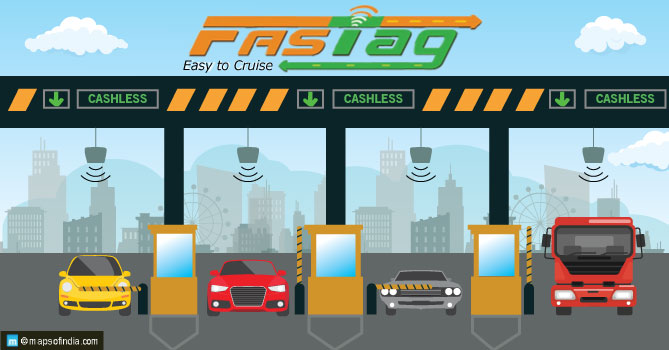
FASTags is now mandatory for all vehicles. An essential part of the National Electronic toll collection program, FASTags are Radio-frequency-Identification enabled tags which are linked with the registration details of their respective vehicles. They are attached to the inner side of a vehicle’s windshield and enable drivers to make swift, contactless payments at toll boots on state and national highways and expressways. There are dedicated lanes with FASTag readers installed at almost all Toll Plazas across the country. When a vehicle with such a tag passes through the dedicated lane, the RFID code on its windshield is detected, read and amount debited of the toll for the respective plaza.
This initiative aims to enable digital toll payment and prevent long queues at the plazas, on expressways. It would eradicate the human interaction quotient from the pay-and-go thoroughfare arrangement. In the years to come, FASTags would also cater to car parking in and around cities.
RFID Technology
Radio-frequency-Identification (RFID) is a wireless communication standard which involves a data-carrying tag, with an integrated circuit and a tiny antenna, which transmits that data to readers installed in the FASTag lanes. These tags are generally of two kinds – active tags which require a constant power supply, and passive tags which activate only upon interaction with a reader.
FASTags are an example of the passive kind. The FASTag system is designed to collect information of their respective vehicle’s identification, the direction of movement and live tracking, and record it on the digital accumulation platform, all without any human interference.
Each FASTag comes with a unique GS1 identification number and this becomes the vehicle identity for digital readers. This allows it to interact with the reader and transmit information regarding that particular vehicle’s due charge for a particular toll, depending on the payment system defined by the traffic police, collection authorities and the state and central governments.
When these tags become widely accepted for all automotive tolls and fees, they would become the default payment method for parking, refuelling, etc. Authorities have prepared an elaborate plan-of-action regarding the applicability of FASTags. To begin with, they ensure minimal cash transactions also aiding the government policy on maximizing electronic financial management. This will also reduce long queues at the plazas, and help bring down congestion, fuel consumption and pollution.
Procuring the FASTag
FASTags can be attained by two primary processes. One can either buy a FASTag at toll plazas pan-India, by presenting valid identification and vehicle registration documentation. These are KYC mandatory processes. One could also buy them online from Amazon, or purchase them at certain bank outlets such as HDFC, ICICI, State Bank of India, Kotak Mahindra, Axis etc. Online financial applications like Airtel Payments Bank and Paytm are also promoting FASTags and are good options for online procurement. Both methods are relevant to the consumer as per their ease-of-use. For example, people who choose to buy them from their local bank can link these cards with their bank account for facilitating quick recharge upon need. People can also use online payment methods such as Payment banks and Paytm, Google Pay etc. However, different vendors are offering different prices for the tags. Buying it from Paytm would cost a person five hundred rupees. This is inclusive of the tag, a refundable security deposit of rupees two hundred and fifty, and an opening recharge amount of a hundred and fifty. Buying it from banks can get you the package for four hundred rupees, inclusive of a two hundred rupee deposit, and hundred rupees each for re-issuance and the tag itself.
Regular usage of these tags on all state and national highways will also reward consumers with cash-backs and value-offers. The minimum threshold amount for all sources would vary depending on their policies. Paytm issued tags have a minimum threshold amount of Rs 150. Payment can be automated using the Paytm account link, where every time one crosses a toll, the money would automatically be deducted from their Paytm balance.
One can also download the My-FASTag app and recharge their tags via the Unified Payments Interface (UPI) app.
FASTags have been based and designed on the D-I-Y concept, wherein customers can enter details on their own and link their tag to their bank account.
Government data indicates that in the last few months, FASTag purchases have multiplied and a total of about six million FASTags have been issued.
The end of November saw voluntary FASTag usage phase come to an end. From the 15th of December 2019, FASTags have been made compulsory, and cars without tags would have to pay a higher toll amount at all plazas across the country, as compared to the ones with them.
The government of India has initiated several new transport and travel reforms to simplify and better control the road network and its traffic.
Related Link:




